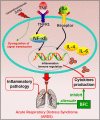Bulbus Fritillariae Cirrhosae as a Respiratory Medicine: Is There a Potential Drug in the Treatment of COVID-19?
- PMID: 35126123
- PMCID: PMC8811224
- DOI: 10.3389/fphar.2021.784335
Bulbus Fritillariae Cirrhosae as a Respiratory Medicine: Is There a Potential Drug in the Treatment of COVID-19?
Abstract
Bulbus fritillariae cirrhosae (BFC) is one of the most used Chinese medicines for lung disease, and exerts antitussive, expectorant, anti-inflammatory, anti-asthmatic, and antioxidant effects, which is an ideal therapeutic drug for respiratory diseases such as ARDS, COPD, asthma, lung cancer, and pulmonary tuberculosis. Through this review, it is found that the therapeutic mechanism of BFC on respiratory diseases exhibits the characteristics of multi-components, multi-targets, and multi-signaling pathways. In particular, the therapeutic potential of BFC in terms of intervention of "cytokine storm", STAT, NF-κB, and MAPK signaling pathways, as well as the renin-angiotensin system (RAS) that ACE is involved in. In the "cytokine storm" of SARS-CoV-2 infection there is an intense inflammatory response. ACE2 regulates the RAS by degradation of Ang II produced by ACE, which is associated with SARS-CoV-2. For COVID-19, may it be a potential drug? This review summarized the research progress of BFC in the respiratory diseases, discussed the development potentiality of BFC for the treatment of COVID-19, explained the chemical diversity and biological significance of the alkaloids in BFC, and clarified the material basis, molecular targets, and signaling pathways of BFC for the respiratory diseases. We hope this review can provide insights on the drug discovery of anti-COVID-19.
Keywords: COVID-19; alkaloids; bulbus fritillariae cirrhosae; respiratory diseases; signaling pathways; targets.
Copyright © 2022 Quan, Li, Yin, Chen, Yi, Lang, Zhang, Yue and Zhao.
Conflict of interest statement
The authors declare that the research was conducted in the absence of any commercial or financial relationships that could be construed as a potential conflict of interest.
Figures










References
Publication types
LinkOut - more resources
Full Text Sources
Other Literature Sources
Miscellaneous

